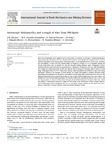Mostrar el registro sencillo del ítem
Anisotropic deformability and strength of slate from NW-Spain
| dc.contributor.author | Alejano, Leandro R. | |
| dc.contributor.author | González Fernández, Manuel Alejandro | |
| dc.contributor.author | Estévez-Ventosa, Xian | |
| dc.contributor.author | Song, Fei | |
| dc.contributor.author | Delgado Martín, Jordi | |
| dc.contributor.author | Muñoz-Ibáñez, Andrea | |
| dc.contributor.author | González-Molano, Nubia | |
| dc.contributor.author | Alvarellos-Iglesias, José | |
| dc.date.accessioned | 2022-01-12T19:40:00Z | |
| dc.date.available | 2022-01-12T19:40:00Z | |
| dc.date.issued | 2021 | |
| dc.identifier.citation | Alejano, L. R., González-Fernández, M. A., Estévez-Ventosa, X., Song, F., Delgado-Martín, J., Muñoz-Ibáñez, A., González-Molano, N., Alvarellos, J. (2021). Anisotropic deformability and strength of slate from NW-Spain. International Journal of Rock Mechanics and Mining Sciences, 148, 104923. | es_ES |
| dc.identifier.uri | http://hdl.handle.net/2183/29373 | |
| dc.description.abstract | [Abstract:] Slates are metamorphic rocks characterized by the pervasive occurrence of cleavage or foliation producing a highly anisotropic mechanical behavior characterized by fissility. Deformability and strength of these rocks are therefore dependent on the cleavage plane orientations relative to the principal stresses. In this study, the failure and deformability of these rocks are experimentally investigated by means of a set of standard uniaxial and triaxial compression tests on samples cut with the cleavage forming different angles. Propagation velocity measurements have also been taken in a good number of specimens. Compression tests show that deformability and strength are clearly anisotropic for this rock and that failure through the cleavage plane is observed in the range of dip angles from 15 to 75°. Transversely isotropic elastic parameters are fit based on improved existing approaches. Moreover, the strength of tested samples cut normal and parallel to foliation relevantly differ, something noted qualitatively in the past by some authors in some metamorphic anisotropic rocks. However, this difference has neither been explicitly reported for the case of other foliated sedimentary rocks such as shales, nor formalized in theoretical strength approaches. The triaxial compression experimental data on slates were fit with the Jaeger's plane of weakness (JPW) model. Strength criteria differentiating the strength in directions normal and parallel to foliation are proposed to adapt the JPW model to the observations in slate strength behavior. Other model improvement is proposed, the use of a non-linear strength criterion for the intact rock (Hoek-Brown), which shows to better represent observed strength laboratory results. | es_ES |
| dc.description.sponsorship | Ministerio de Universidades; RTI2018-093563-B-I00 | es_ES |
| dc.language.iso | eng | es_ES |
| dc.publisher | Elsevier | es_ES |
| dc.relation.uri | https://doi.org/10.1016/j.ijrmms.2021.104923 | es_ES |
| dc.rights | Atribución-NoComercial-SinDerivadas 3.0 España | es_ES |
| dc.rights.uri | http://creativecommons.org/licenses/by-nc-nd/3.0/es/ | * |
| dc.subject | Slate | es_ES |
| dc.subject | Anisotropy | es_ES |
| dc.subject | Transversely isotropic elasticity | es_ES |
| dc.subject | Strength | es_ES |
| dc.subject | JPW | es_ES |
| dc.title | Anisotropic deformability and strength of slate from NW-Spain | es_ES |
| dc.type | info:eu-repo/semantics/article | es_ES |
| dc.rights.access | info:eu-repo/semantics/openAccess | es_ES |
| UDC.journalTitle | International Journal of Rock Mechanics and Mining Sciences | es_ES |
| UDC.volume | 148 | es_ES |
| UDC.startPage | 104923 | es_ES |
| dc.identifier.doi | 10.1016/j.ijrmms.2021.104923 |






